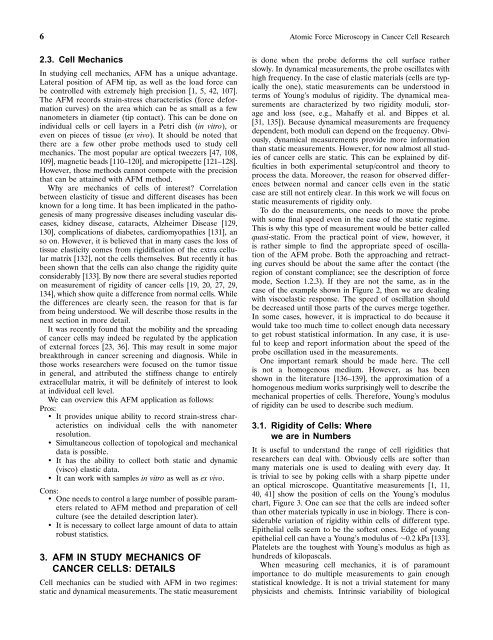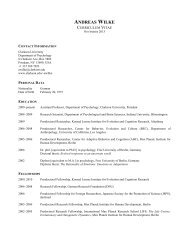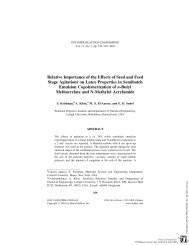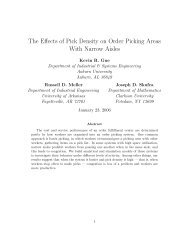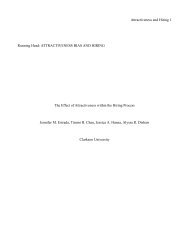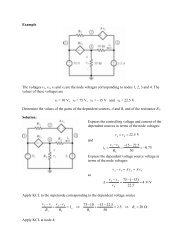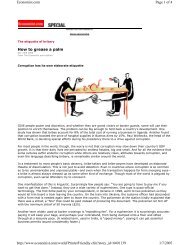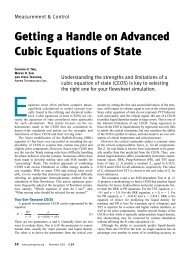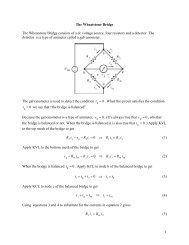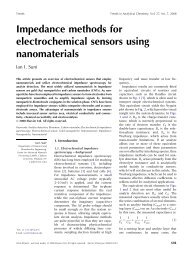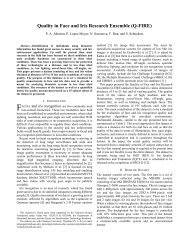Atomic Force Microscopy in Cancer Cell Research - Clarkson ...
Atomic Force Microscopy in Cancer Cell Research - Clarkson ...
Atomic Force Microscopy in Cancer Cell Research - Clarkson ...
You also want an ePaper? Increase the reach of your titles
YUMPU automatically turns print PDFs into web optimized ePapers that Google loves.
6 <strong>Atomic</strong> <strong>Force</strong> <strong>Microscopy</strong> <strong>in</strong> <strong>Cancer</strong> <strong>Cell</strong> <strong>Research</strong><br />
2.3. <strong>Cell</strong> Mechanics<br />
In study<strong>in</strong>g cell mechanics, AFM has a unique advantage.<br />
Lateral position of AFM tip, as well as the load force can<br />
be controlled with extremely high precision [1, 5, 42, 107].<br />
The AFM records stra<strong>in</strong>-stress characteristics (force deformation<br />
curves) on the area which can be as small as a few<br />
nanometers <strong>in</strong> diameter (tip contact). This can be done on<br />
<strong>in</strong>dividual cells or cell layers <strong>in</strong> a Petri dish (<strong>in</strong> vitro), or<br />
even on pieces of tissue (ex vivo). It should be noted that<br />
there are a few other probe methods used to study cell<br />
mechanics. The most popular are optical tweezers [47, 108,<br />
109], magnetic beads [110–120], and micropipette [121–128].<br />
However, those methods cannot compete with the precision<br />
that can be atta<strong>in</strong>ed with AFM method.<br />
Why are mechanics of cells of <strong>in</strong>terest? Correlation<br />
between elasticity of tissue and different diseases has been<br />
known for a long time. It has been implicated <strong>in</strong> the pathogenesis<br />
of many progressive diseases <strong>in</strong>clud<strong>in</strong>g vascular diseases,<br />
kidney disease, cataracts, Alzheimer Disease [129,<br />
130], complications of diabetes, cardiomyopathies [131], an<br />
so on. However, it is believed that <strong>in</strong> many cases the loss of<br />
tissue elasticity comes from rigidification of the extra cellular<br />
matrix [132], not the cells themselves. But recently it has<br />
been shown that the cells can also change the rigidity quite<br />
considerably [133]. By now there are several studies reported<br />
on measurement of rigidity of cancer cells [19, 20, 27, 29,<br />
134], which show quite a difference from normal cells. While<br />
the differences are clearly seen, the reason for that is far<br />
from be<strong>in</strong>g understood. We will describe those results <strong>in</strong> the<br />
next section <strong>in</strong> more detail.<br />
It was recently found that the mobility and the spread<strong>in</strong>g<br />
of cancer cells may <strong>in</strong>deed be regulated by the application<br />
of external forces [23, 36]. This may result <strong>in</strong> some major<br />
breakthrough <strong>in</strong> cancer screen<strong>in</strong>g and diagnosis. While <strong>in</strong><br />
those works researchers were focused on the tumor tissue<br />
<strong>in</strong> general, and attributed the stiffness change to entirely<br />
extracellular matrix, it will be def<strong>in</strong>itely of <strong>in</strong>terest to look<br />
at <strong>in</strong>dividual cell level.<br />
We can overview this AFM application as follows:<br />
Pros:<br />
• It provides unique ability to record stra<strong>in</strong>-stress characteristics<br />
on <strong>in</strong>dividual cells the with nanometer<br />
resolution.<br />
• Simultaneous collection of topological and mechanical<br />
data is possible.<br />
• It has the ability to collect both static and dynamic<br />
(visco) elastic data.<br />
• It can work with samples <strong>in</strong> vitro as well as ex vivo.<br />
Cons:<br />
• One needs to control a large number of possible parameters<br />
related to AFM method and preparation of cell<br />
culture (see the detailed description later).<br />
• It is necessary to collect large amount of data to atta<strong>in</strong><br />
robust statistics.<br />
3.AFM IN STUDY MECHANICS OF<br />
CANCER CELLS: DETAILS<br />
<strong>Cell</strong> mechanics can be studied with AFM <strong>in</strong> two regimes:<br />
static and dynamical measurements. The static measurement<br />
is done when the probe deforms the cell surface rather<br />
slowly. In dynamical measurements, the probe oscillates with<br />
high frequency. In the case of elastic materials (cells are typically<br />
the one), static measurements can be understood <strong>in</strong><br />
terms of Young’s modulus of rigidity. The dynamical measurements<br />
are characterized by two rigidity moduli, storage<br />
and loss (see, e.g., Mahaffy et al. and Bippes et al.<br />
[31, 135]). Because dynamical measurements are frequency<br />
dependent, both moduli can depend on the frequency. Obviously,<br />
dynamical measurements provide more <strong>in</strong>formation<br />
than static measurements. However, for now almost all studies<br />
of cancer cells are static. This can be expla<strong>in</strong>ed by difficulties<br />
<strong>in</strong> both experimental setup/control and theory to<br />
process the data. Moreover, the reason for observed differences<br />
between normal and cancer cells even <strong>in</strong> the static<br />
case are still not entirely clear. In this work we will focus on<br />
static measurements of rigidity only.<br />
To do the measurements, one needs to move the probe<br />
with some f<strong>in</strong>al speed even <strong>in</strong> the case of the static regime.<br />
This is why this type of measurement would be better called<br />
quasi-static. From the practical po<strong>in</strong>t of view, however, it<br />
is rather simple to f<strong>in</strong>d the appropriate speed of oscillation<br />
of the AFM probe. Both the approach<strong>in</strong>g and retract<strong>in</strong>g<br />
curves should be about the same after the contact (the<br />
region of constant compliance; see the description of force<br />
mode, Section 1.2.3). If they are not the same, as <strong>in</strong> the<br />
case of the example shown <strong>in</strong> Figure 2, then we are deal<strong>in</strong>g<br />
with viscoelastic response. The speed of oscillation should<br />
be decreased until those parts of the curves merge together.<br />
In some cases, however, it is impractical to do because it<br />
would take too much time to collect enough data necessary<br />
to get robust statistical <strong>in</strong>formation. In any case, it is useful<br />
to keep and report <strong>in</strong>formation about the speed of the<br />
probe oscillation used <strong>in</strong> the measurements.<br />
One important remark should be made here. The cell<br />
is not a homogenous medium. However, as has been<br />
shown <strong>in</strong> the literature [136–139], the approximation of a<br />
homogenous medium works surpris<strong>in</strong>gly well to describe the<br />
mechanical properties of cells. Therefore, Young’s modulus<br />
of rigidity can be used to describe such medium.<br />
3.1. Rigidity of <strong>Cell</strong>s: Where<br />
we are <strong>in</strong> Numbers<br />
It is useful to understand the range of cell rigidities that<br />
researchers can deal with. Obviously cells are softer than<br />
many materials one is used to deal<strong>in</strong>g with every day. It<br />
is trivial to see by pok<strong>in</strong>g cells with a sharp pipette under<br />
an optical microscope. Quantitative measurements [1, 11,<br />
40, 41] show the position of cells on the Young’s modulus<br />
chart, Figure 3. One can see that the cells are <strong>in</strong>deed softer<br />
than other materials typically <strong>in</strong> use <strong>in</strong> biology. There is considerable<br />
variation of rigidity with<strong>in</strong> cells of different type.<br />
Epithelial cells seem to be the softest ones. Edge of young<br />
epithelial cell can have a Young’s modulus of ∼0.2 kPa [133].<br />
Platelets are the toughest with Young’s modulus as high as<br />
hundreds of kilopascals.<br />
When measur<strong>in</strong>g cell mechanics, it is of paramount<br />
importance to do multiple measurements to ga<strong>in</strong> enough<br />
statistical knowledge. It is not a trivial statement for many<br />
physicists and chemists. Intr<strong>in</strong>sic variability of biological


